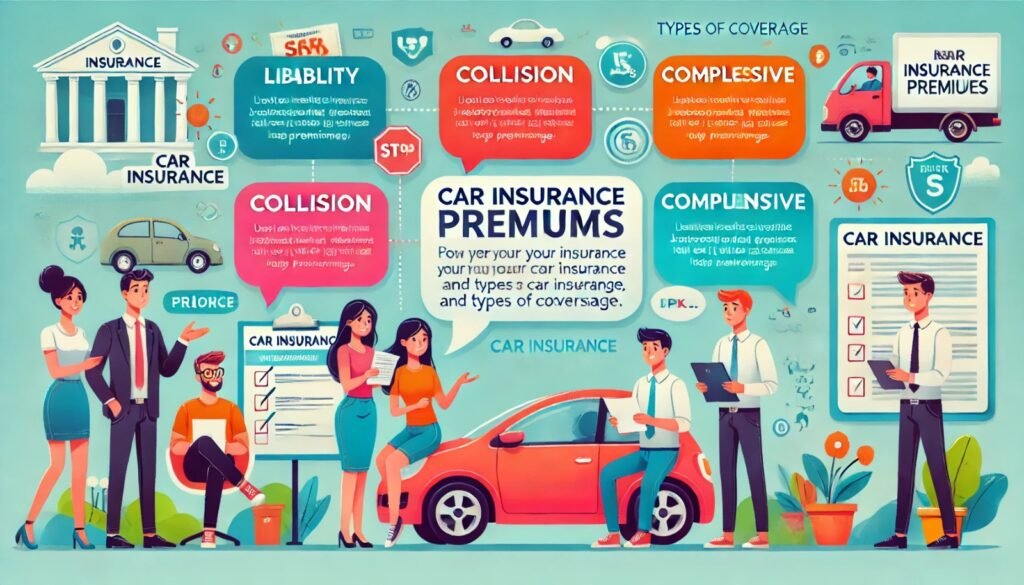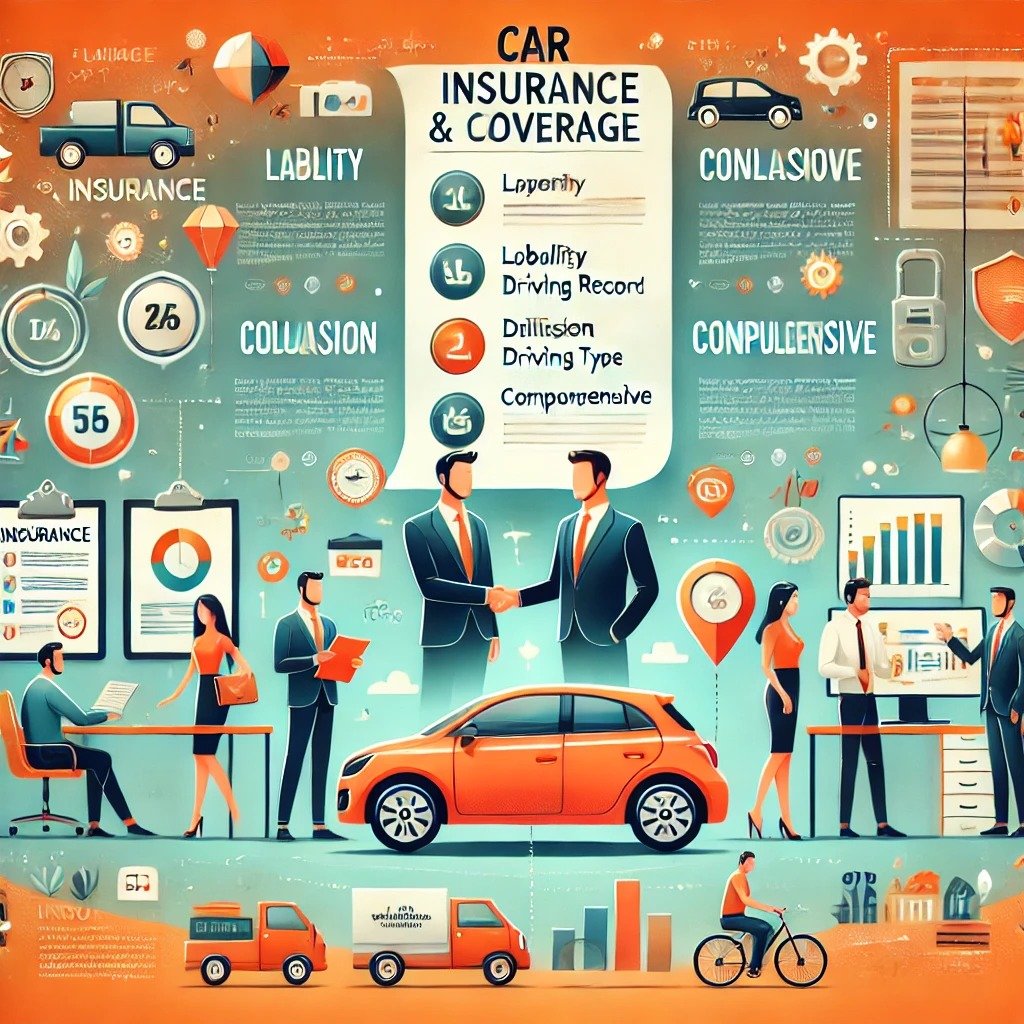A perfect guide to new car owners and drivers about car insurance premiums and coverage: discover how the car insurance premium and coverage works and how it is influenced by certain factors to make a wise decision.
Introduction of Car Insurance Premiums:
Car insurance premiums are mandatory for all new car owners and drivers. This policy protects your vehicle from damage and loss in case of an accident. However, some people are confused about the car insurance premium and coverage. This guide will help them to make an informed decision about your vehicle. This guide dives into the understanding of car insurance premiums and coverage, how it works, and the factors that influence car insurance premiums.
What is a car insurance premiums?
The car insurance premiums is the amount you pay annually, bi-annually, or monthly to continue your policy. The company ensures you cover the damage or loss in case of accident or theft. The premium depends on several factors such as the insurance company, level of policy, and your location.
Key factors influencing the car insurance premiums:
Driving records:
One of the most important factors that influence your car insurance premium. Since the insurance companies prefer safe-driving record drivers and lower premiums they are low-risk customers. However, if you have a history of accidents or other driving violence, your premium will be higher as there are more chances of accidents.
Vehicle type:
Newer vehicles, electric vehicles, sports cars, and other expensive cars have higher premiums because of the high repair cost and higher risk. On the other hand, high safety vehicle costs less premium and the company offers discounts too.
Where you live:
Location is another crucial factor. People live in areas with high rates of accidents and vehicle theft, insurance may charge a high premium. Therefore, the people living in rural areas have to pay a high premium as these areas have a high risk of accidents due to traffic congestion.
Age and gender:
Age and gender are also considered by the insurers. Usually, young drivers are involved in risky activities and pay high premiums. If we talk about gender, males are considered risky drivers, so they pay more premiums than females.
Household status:
Singles may pay more for the policy, as married couples have fewer chances of accidents than singles.
Driving experience:
Less experienced drivers pay a high premium as they are more likely to be involved in accidents. However, the premium becomes less with time, as you become experienced.
Type of coverage:
Another important factor is the coverage type. In most insurance policies, the premium amount directly depends on the coverage type. The more comprehensive coverage you buy, the higher the premium is.

Types of car coverages:
Understanding your options for available coverage types is important to purchase car insurance. Many coverage types cover the loss due to accidents or damage to your vehicle while others pay for the damage to other property. Here are the common coverage types of car insurance:
Collision
Comprehensive
Liability
Uninsured or underinsured motorist
Medical payments
Collison coverage:
Collision coverage covers the damage to your vehicle due to the collision with another vehicle or other object. The company pays for the repair regardless of fault. The collision coverage includes the deductible, which you have to pay out of pocket before the policy kicks in. The policy is not mandatory but offers for the newer drivers and the new vehicles.
Comprehensive coverage:
Comprehensive coverage covers non-collision damage, it covers the damage due to natural disasters such as floods, earthquakes, or damage because of animal contact, etc. This coverage does not include deductible as the collision coverage.
Liability coverage:
Liability coverage covers the damage to other vehicles or injuries you cause to others. This coverage does not cover the damage to the policyholder’s vehicle. There are two main parts of liability coverage:
Bodily injury liability:
If you have injured other individuals in an accident the coverage bears the medical expenses.
Property damage liability:
If you have damaged other’s vehicle in an accident the company pays for the repair and replacement of the property.
Uninsured or underinsured motorist:
This coverage involves the protection of your vehicle if you are hit by another driver’s vehicle who either has no policy or limited coverage.
Medical payment coverage:
This coverage is distinct from personal coverage in certain factors, but somehow it is similar to personal coverage. It covers the medical expenses of the passengers, family members, and policyholders. It can be a supplement for individuals who don’t have health insurance that covers accident-related expenses.
Car insurance premiums offered by companies:
| Company | Average annual Car insurance premium |
| USSA | $1,141 |
| Geico | $1,182 |
| State Form | $1,402 |
| Erie | $1,419 |
| Travelers | $1,435 |
| Auto insurance | $1,532 |
| Nationwide | $1,540 |
| Progressive | $1,892 |
| Allstate | $2,022 |
| Formers | $2,1124 |
Ways to lower your car insurance premiums:
Here are some tips to lower your premium:
Increase deductibles:
One of the most common ways to lower your premium is to increase your deductible. Nevertheless, make sure you can easily pay the deductible at the time of claim.
Ask for discounts:
Companies offer discounts for safe and experienced drivers, who have multiple policies and a clean driving history. Must ask for discounts maybe you are eligible for the discounts.
Shop around:
Shopping around is a beneficial way to find a policy with low premiums. Compare the different quotes to buy the adequate policy. There is a major difference in the premium costs between companies e.g. hundreds or thousands of dollars.
Purchase usage-based insurance:
If you drive frequently or use the vehicle for short distances, the usage-based policy will lower the premium rate.
Healthy credit score:
If your credit score is healthy, beneficial in lowering the premium rate. With the improved credit score, you pay the premium and deductible timely.
Summary:
Understanding the car insurance premium and coverage is important for choosing affordable and comprehensive coverage. The factors to consider are coverage type, vehicle type driving record, etc. Always keep in mind the comparison of companies’ quotes, and ask for discounts and usage-based insurance to lower the premium rate.
By understanding these factors, you can make an informed decision that is affordable and ensures your protection on the road.
FAQs:
How should I pay the premium, annually or monthly?
The payment of the premium depends on your financial obligations. If you can pay a lump-sum amount, go for an annual payment. If you pay annually, company will offer you discounts. On the other, if your financial condition doesn’t allow you to pay a lump-sum amount, go for the monthly payment.
What is the difference between car insurance premiums and car insurance quotes?
Car insurance premium is the amount you pay annually or monthly to activate your policy while the insurance quote is the estimation of the costs of the premium.
Which type of car insurance policy is best?
A comprehensive car insurance premiums policy is the best one since it offers all the basic coverages and protects you completely. Furthermore, it provides death benefits to the policyholder’s family.

